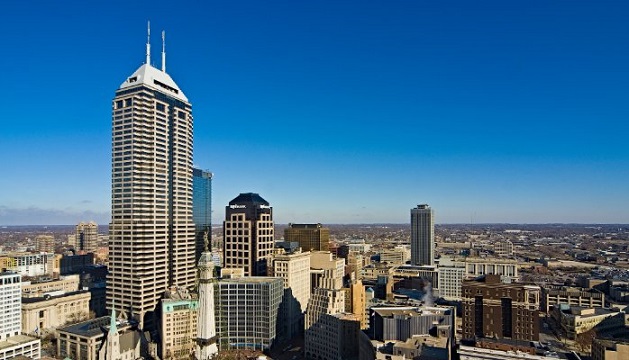
CHICAGO—High-tech was nurtured in Silicon Valley, but even as the sector's soaring growth has moderated somewhat, it has also started to sink roots in new cities and regions, perhaps providing these areas with the resilience to withstand economic downturns. That was one of the conclusions of a research team from Chicago-based JLL, which just released its latest Tech Office Outlook report, a study of the top 45 metro areas.
As reported in GlobeSt.com, there was a modest pullback from tech office users in the second quarter, and that was partly the result of a pullback from the venture capitalists that have funded the sector. Cutting costs has become more important in the industry, and that has its leaders looking to spread out to lower cost markets.
“Chicago has gotten a lot of traction in the past five and a half years,” Steffen Kammerer, senior vice president and leader of JLL's technology group, tells GlobeSt.com. In addition to its increasingly strong start-up scene, the city and its suburbs have office spaces that cost a fraction of ones in Silicon Valley and other top tech centers. Direct average asking rents in its burgeoning West Loop submarket were $28.76, compared to $74.69 in San Francisco's South Financial District and $76.77 in New York's Times Square.
And in the past year, Chicago broke into the top five markets in terms of tech leasing. Its more than 1.7 million square feet put the metro area in fourth place, far behind the leader Silicon Valley with 3.9 million square feet, but just ahead of San Francisco and New York.

Other cities also showed surprising strength, and illustrate just how much the tech landscape has changed. Indianapolis, for example, reached the top ten with about 984,000 square feet of tech leasing activity in the past year. Salesforce.com, a San Francisco-based cloud computing giant, has driven much of Indianapolis' recent activity. The company anchors an eight-floor, historic building in the downtown, but recently decided to take on an additional 227,781 square feet in Chase Tower, a traditional, modern office building, the state's tallest, that in 2017 will be renamed Salesforce Tower.
Other big players in the tech world have started to question whether they need to have all of their employees in just a few, high-cost markets. Lyft, the San Francisco-based ride sharing service, decided in 2015 to open up a 35,000 square foot call center in Nashville, one of the hottest secondary markets in the US. And moves like that have become common.
“People are open to exploring new markets more than ever,” says Kammerer. He praises Nashville's highly-educated workforce, and says it is cities like this, ones that attract young workers, that will benefit the most from tech firms spreading out across the US. Other top destinations include Minneapolis and Dallas.
But even with all of this new exploration, JLL still scored Silicon Valley as the nation's most resilient market. “It wasn't a surprise that Silicon Valley came out on top,” says Amber Schiada, vice president, director of research, Northern California. The region may have astronomical costs, but its deep talent base, access to venture capital and sheer momentum means it can probably withstand even the strongest economic headwinds.
More surprising was the strength that JLL found in Minneapolis. The depth of its talent pool, its highly-educated workforce, and the number of its patents and ability to attract venture capital funding, provide “a strong foundation for market resilience through industry ups and downs.”

CHICAGO—High-tech was nurtured in Silicon Valley, but even as the sector's soaring growth has moderated somewhat, it has also started to sink roots in new cities and regions, perhaps providing these areas with the resilience to withstand economic downturns. That was one of the conclusions of a research team from Chicago-based JLL, which just released its latest Tech Office Outlook report, a study of the top 45 metro areas.
As reported in GlobeSt.com, there was a modest pullback from tech office users in the second quarter, and that was partly the result of a pullback from the venture capitalists that have funded the sector. Cutting costs has become more important in the industry, and that has its leaders looking to spread out to lower cost markets.
“Chicago has gotten a lot of traction in the past five and a half years,” Steffen Kammerer, senior vice president and leader of JLL's technology group, tells GlobeSt.com. In addition to its increasingly strong start-up scene, the city and its suburbs have office spaces that cost a fraction of ones in Silicon Valley and other top tech centers. Direct average asking rents in its burgeoning West Loop submarket were $28.76, compared to $74.69 in San Francisco's South Financial District and $76.77 in
And in the past year, Chicago broke into the top five markets in terms of tech leasing. Its more than 1.7 million square feet put the metro area in fourth place, far behind the leader Silicon Valley with 3.9 million square feet, but just ahead of San Francisco and

Other cities also showed surprising strength, and illustrate just how much the tech landscape has changed. Indianapolis, for example, reached the top ten with about 984,000 square feet of tech leasing activity in the past year. Salesforce.com, a San Francisco-based cloud computing giant, has driven much of Indianapolis' recent activity. The company anchors an eight-floor, historic building in the downtown, but recently decided to take on an additional 227,781 square feet in Chase Tower, a traditional, modern office building, the state's tallest, that in 2017 will be renamed Salesforce Tower.
Other big players in the tech world have started to question whether they need to have all of their employees in just a few, high-cost markets. Lyft, the San Francisco-based ride sharing service, decided in 2015 to open up a 35,000 square foot call center in Nashville, one of the hottest secondary markets in the US. And moves like that have become common.
“People are open to exploring new markets more than ever,” says Kammerer. He praises Nashville's highly-educated workforce, and says it is cities like this, ones that attract young workers, that will benefit the most from tech firms spreading out across the US. Other top destinations include Minneapolis and Dallas.
But even with all of this new exploration, JLL still scored Silicon Valley as the nation's most resilient market. “It wasn't a surprise that Silicon Valley came out on top,” says Amber Schiada, vice president, director of research, Northern California. The region may have astronomical costs, but its deep talent base, access to venture capital and sheer momentum means it can probably withstand even the strongest economic headwinds.
More surprising was the strength that JLL found in Minneapolis. The depth of its talent pool, its highly-educated workforce, and the number of its patents and ability to attract venture capital funding, provide “a strong foundation for market resilience through industry ups and downs.”
Want to continue reading?
Become a Free ALM Digital Reader.
Once you are an ALM Digital Member, you’ll receive:
- Breaking commercial real estate news and analysis, on-site and via our newsletters and custom alerts
- Educational webcasts, white papers, and ebooks from industry thought leaders
- Critical coverage of the property casualty insurance and financial advisory markets on our other ALM sites, PropertyCasualty360 and ThinkAdvisor
Already have an account? Sign In Now
*May exclude premium content© 2025 ALM Global, LLC, All Rights Reserved. Request academic re-use from www.copyright.com. All other uses, submit a request to [email protected]. For more information visit Asset & Logo Licensing.








